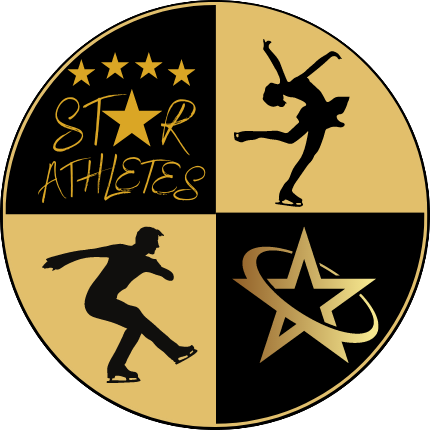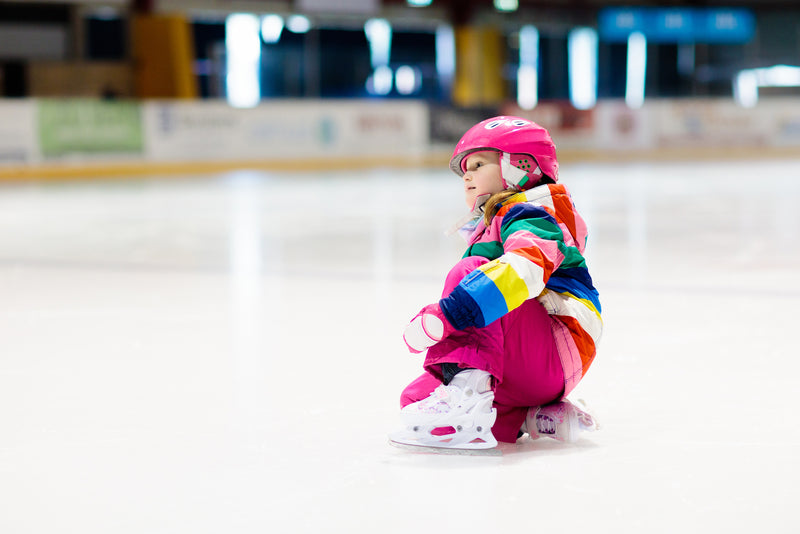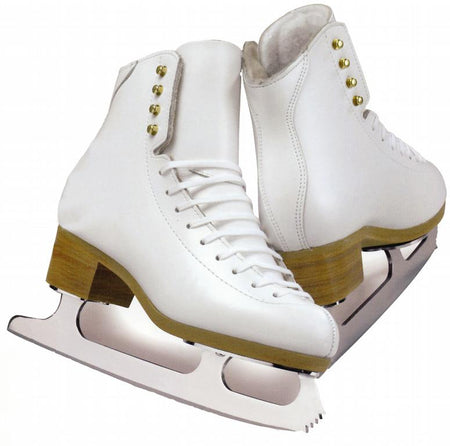The world of figure skating might feel overwhelming at the beginning, but you are not alone and we can help you with some tips to make you feel at ease.
#1 - Book lessons
First thing to do is to refrain from teaching your kid how to ice skate yourself. Whether you can or cannot skate properly, you must consider professional training for your child.
To start with the right basis and not take bad habits from the start, lessons are a must.
Most ice rinks have a skating club that is affiliated to them and these clubs and sometimes even the rinks have a skating academy offering skating lessons for beginner skaters. If you are in Canada, once enrolled your kid will be following the Canskate program and in the US skaters follow the Learn to skate USA program.

No need to get private lessons at the beginning, as the group classes are best suited for beginners, it is also where kids generally make friends and stay motivated.
Most classes have play-way training methods, and the entertainment plays a big role in applying the techniques. Most clubs have skating lessons for kids 3+ and everyone can skate, even adults and teens.
#2 - Make sure to have the right equipment for your ice skating lessons
For the lessons to be fructuous from day 1, the kids must have proper gear. Here is what we recommend:
Thin socks – NO THICK SOCKS as they must be able to feel the positions on their feet. They will be more in control of the moves.
Warm clothes – Go for something warm yet light-weight so that there is no bulk. No ski pants and make sure to avoid jeans as well.
Gloves – The simplest and most practical reason for gloves is simply protection. Wearing gloves helps skaters keep their hands warm while out on the ice. They also offer a layer of protection in case of a fall, or if a skater performs a tricky move that requires them to grab their blade with their hand.
Helmet – Most clubs do not allow kids to skate without a helmet on. In Canada for instance skaters are only allowed to remove their helmets after they pass their Canskate 5. You want hat helmet on for beginners even for adults. Head injuries are common in skating. Wearing a helmet can help to prevent serious injuries and concussions. It is important to make sure that the helmet fits properly.
Make sure to tell your kid that falling is a part of the learning to skate process.

#3 - Tie skates properly
Properly lacing the skates ensures that the foot stays in a naturally locked position while you skate.

Lacing and tying up the skate is important for anyone who is trying out ice skating. The laces should be ddone properly to ensure that your skaters will be comfortable. Ankle support is crucial. If the child falls, the ankle is vulnerable to twists and sprains and it can put them out of action for long. You can tie the skates if your kid is too young, but make sure to teach them how to do it by themselves if they are 8 or older.
Here is a helpful video from Jackson showing you How to Lace your Jackson Figure Skates:
#4 - It is crucial to have good skates
At the beginning of your ice skating journey, little children can manage just fine on rental skates or even used skates. However, as soon as you know that your child likes the sport, you should buy a pair of skates. Rental skates can help only so much, as the wear and tear are high, and performance is quite low in these skates. You can follow this guide to buy your child their first pair:
They must not be too big because figure skating requires a high degree of control. The fit must be exactly right, not too tight either. If the skates are fully loosened up and the foot is pushed forward, there must be one finger space between the heel and the shoe.
The skates must not be from the adjustable variety as they are not very good for learning more technical figure skating moves.
Check if the child is comfortable. For sport or even as a hobby, you don’t want your kid to be suffering in a poorly fitted skate. Check if the padding is present, if it is enough for the child to feel good in, and whether is it high density foam to protect their little feet.
And don't forget to have them sharpened!
The Jackson brand is a solid well-known brand. It is used by the beginner all the way up to the olympians.

#5 - Do not pretend to be a coach
Always let the child get into an enjoyment mode before you can make it a regular activity. But as the child learns and explores more about the sport, you should learn more too.
You can:
- Read about figure skating to understand better what moves your child is doing so that you can congratulate more precisely
- Learn yourself to skate - take a few lessons so you can understand the basics. And adult classes are often really fun!
- However, don't pretend to be a coach. it creates frustration both for the kid and for the real coach!
- Plus, I recommend you don't sit close to the rink. If parents are allowed to watch, you should sit away from the rink so that your child is not distracted trying to seek your approval. This is especially true when they are little.
#6 - Teach your skater how to take care of the skates
Being a young and new skater or a seasoned one, all skaters and sportspeople must respect the equipment. This is something that should be taught from a young age.
You must teach the children these essential steps to take care of skates as they begin taking lessons and learning.
- The skater must wear skate guards as soon as he/she leaves the ice. This helps protect the blades as even a tiny damage to the blade can prevent from skating properly (not provided with rental skates, but as soon as you purchase new ones, you should get skate guards).
- The skater must learn to properly dry out the blades after each practice. This prevents rusting of the blades. You can make is more fun by offering your child a personalized towel especially for it. Check out my article about blade towels.
- The skater must carry his skates in a bag with soakers to protect the blades, as the moisture on the blades can damage them.
- The skater must remember to dry the skates out the moment he reaches home.
#7 - Make sure your skater warms up and stretches
Warming up before and stretching after any activity should be an automatism. We are not taught this enough.
Sports is all about muscle performance, and this can increase, and injury be avoided if warm-up and stretching are done properly.
Make sure to do a few exercises with your kid and warm up with a few:
- Squats,
- Rotations of the back,
- Rotation of the shoulders,
- Rotations of the neck
- Stretch The thighs (there is a lot of ups and downs in ice skating)
- Stretch The calves
Try to make it an automatism for your kid to do those things before and after a sport session!
#8 Stay hydrated
For any sport, hydration is must. Always carry a bottle of water for the skater as it can be taxing for their little bodies.
Sometimes because it is cold and the child does not go fast, we don't realize the effort involved. But trust me it is a workout! Hydration is required. It is essential to avoid injuries.
Parents you must always bring/pack a nice bottle of water for the end of practice and make sure your kids hydrate.
#9 - Take care of your skater's feet
Ice skates can be uncomfortable if they get sweaty and create friction. This can also lead to blisters and sore feet.
Make sure to:
- Check for and take care of the blisters.
- Change socks often and not use the same socks over and over again.
- Use socks without seams and reaching over the boot.
- Double-check how well the skates fit.
- Learn how to tie the skates in a better way.
- Ask the child’s coach for tips.
#10 - KEEP IT FUN! What to say and what not to say
Before it is a sport, ice skating should be fun. Don't be impatient and don't rush at the first fall.
Consider the following:
- Let them fall. Most of the time falling is mostly surprising more than it is painful and it is a part of the learning curve. Encourage them to get back up with a smile.
- Do not congratulate that they did not fall at all. This will induce shame if they fall. Normalize falling.
- Ask and make sure they had fun
- If you kid start crying a little, invent a story, make up a character and ask them to imagine if they were feeling like a penguin (for small children). However, if it is at each lesson, maybe this is not the right sport.
- Congratulate on a good move / good control.
- Never force them. Let them be. If they are not okay even after a few sessions, maybe this sport is not for them. It is alright if it isn’t.
Helpful tips for parents
Now, we have talked a lot about your kid but not much about you.
Here are a few tips to consider in order to take care of yourself:
Wear warm clothes - no need to try and be fancy - nice heels are not the most comfortable while waiting at the rink!
Find other parents which are not too intense. Stay away from the politics of the club at the beginning.
Depending on the quality of the stands at your rink, you may want to bring a seat cushion (see the example below)
Watch your kid a little, but also take advantage of this time to do something for you - read a good book, listen to a podcast...



0 comments